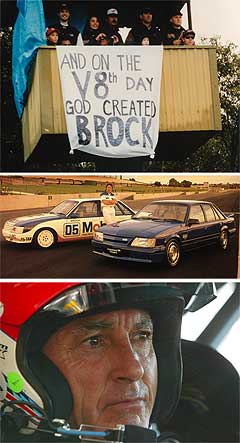Make / Model Search
News - HoldenHow I beat Peter Brock on the trackVale the champ: Peter Brock with one of his many Brock Holdens. Effortless car control marked race champ as one of the best of his generation13 Sep 2006 By JOHN MELLOR EVERYONE will have their Brock stories. Mine date from the mid-1970s when he was starting to make his mark both on the track and as Holden property. Brock used to call in at the offices of Motor Manual, an Age magazine I was editing at the time, to drop off copy and talk cars. Another attraction was yet more rounds of Pencil Point 500, a game played on graph paper with a motor racing circuit – any motor racing circuit – traced over it. It had been published in an American car magazine and had become widely adopted by the motoring staff at Age Magazines. Without going into too much detail, Pencil Point 500 players moved in turn both accelerating (increasing the number of squares advanced with each turn) and braking (decreasing the number of squares reduced by turn). I am pleased to report (and have done so for three decades) that I beat Brocky at Pencil Point 500. But not for long. The super-competitive Brock took very little time to realise that stealth (neither accelerating nor braking too hard) and a correct racing line was the fastest way around the paper track. It was actually the same as the way he drove. The first time I drove with him, Brocky had convinced Holden to build an HQ SS Kingswood up to his specs and we spent an afternoon at Calder Raceway trying it out. That was the day I realised the difference between us mortals and a truly talented racing driver. Brock’s car control, at speeds I would never contemplate as a driver, even on a circuit, was just so effortless. He never gave a car a fright – no sudden braking or sharp swing at the wheel. Everything was so progressive, effortless and easy and his cars rewarded him by staying in one piece while other drivers were tearing their machines apart with aggressive moves at the controls. Brock didn’t just sit in a car. He was the car. On the rallycross circuit at Calder Raceway, Brocky had his new Kingswood pride and joy totally crossed up on a long corner when a large rock loomed in the cornering line. A minor tweak at the wheel – it was as though he had simply moved his weight in the seat – and the line widened leaving the rock out of harm’s way. He just looked across and grinned. He loved that he had that sort of control. If Peter had a failing it was his ability to let emotion cloud his judgment in relationships and nothing was more damaging to him than the emotional blinkers he wore during the polariser affair. Larry Perkins dismissed the polariser on TV the other night as insignificant. But it was significant, not because he had fallen under the spell of spin and wishful thinking, but because he allowed it to destroy the relationship with his greatest ally – Holden. This little box of resin and wires was being espoused by Brock as having special powers over the way a car handled and performed and he was fitting them to the HDT cars he was preparing as part of his alliance with Holden. Trouble is Holden could not go along with it because it was a legal minefield that was never going to pass Trade Practices guidelines. Peter took it personally and even though Holden was desperate for a way out, Brocky stood firm – the polariser or nothing. In a conversation with then Holden chief Chuck Chapman, Chapman was clearly desperate to "knock some sense into him". I asked if there was anything I could do by talking to Brock. But Brocky had hunkered down. He would not see reason. The die was cast. Brock lost the gravy train.  A few years later Brocky and I sat on the banks of the Hume Weir chatting privately about the fact that he had been reduced to putting his name on a Lada Samara. A few years later Brocky and I sat on the banks of the Hume Weir chatting privately about the fact that he had been reduced to putting his name on a Lada Samara.Publicly he was all upbeat and full of bravado but as we talked he looked at me and said: "I’ve blown it, haven’t I." It wasn’t a question. But neither of us realised at that moment that Peter was about to tap into the wealth of goodwill that he had laid down with his fans and with his road safety work in schools. The thousands of kids he sat with on the classroom steps after he had finished talking road safety with them, the signing of autographs late into the night, the interest he showed in people so that they always felt they were important to him as he chatted to them. All this residual goodwill came to his rescue in the form of market research. Quite simply, Holden found, in survey after survey, that the person most associated with the brand was Peter Brock. After time it made no sense to keep him at arms length and he was reunited with the brand that made him and the brand he helped make. Brock - wrong car, wrong place THE chilling aspect of Peter Brock’s death is that it was exactly the kind of accident he was trying to prevent in a lifetime of working with school kids before they ventured out on our roads. The aerial shots of the crash scene showed a long skid mark off the apex of the corner into the tree that took Brocky’s life. The loss of control was just so typical of the accidents that take the lives of young drivers month after month, year after year. Brocky would talk to kids in school about over-confidence where speed would overtake grip and drivers would become a passenger in their own car as it slides out of control into a tree or pole. In the end, Brock fell victim to the very thing he was trying stop. Here was driving a replica of a car based on a 1960s American design – hardly an era renowned for good handling vehicles and safety features that allow modern rally drivers to survive massive accidents unscathed. The car – the Daytona coupe version of the AC Cobra – was designed for the high speeds of American speedways and racing circuits like Le Mans not the winding bush roads of Western Australia. Brock had already expressed concern he was having trouble coming to grips with the power and the handling of the Daytona. If only he realised he was travelling such a deadly parallel path to that of so many younger men who have died before him because grip failed to match power. But what was Peter Brock doing in this car? Why (like Jim Clark) did a motor racing icon die driving an unimportant car in an unimportant event? Maybe it was the lure of a car with a history that involved another Peter Brock. We know that Brocky was a spiritual guy and maybe he had drawn some connection to the car and his namesake who designed it. In the early 1960s (when Brocky was in his teens) a US sports car driver, Peter (Pete) Brock, was at the height of his driving career and was also highly regarded as an designer. During this time Carroll Shelby married a 4.7 litre Ford V8 into an AC sports car to create the AC Cobra in an effort to defeat both Ferrari and the Chevrolet Corvette Sting Rays at the track But the Cobra, for all its brute force, lacked aerodynamics and Pete Brock convinced Shelby to let him design a coupe. The Daytona, with a top speed 30km/h higher than the AC Cobra, was the result. In 1964 it was defeated in the World Championships by a slim margin by Ferrari and in 1965 (Ferrari withdrew) it won eight of the 11 races. The Daytona also won Le Mans in 1964 and 1965 before rule changes saw its demise. Only six were made. Maybe Brocky saw some links in getting involved with replicas. The final chilling factor is that Brocky, after years in Holdens without getting hurt, died in what was, to all intents and purposes, a Ford. |
Click to shareHolden articlesResearch Holden Motor industry news |









Facebook Twitter Instagram